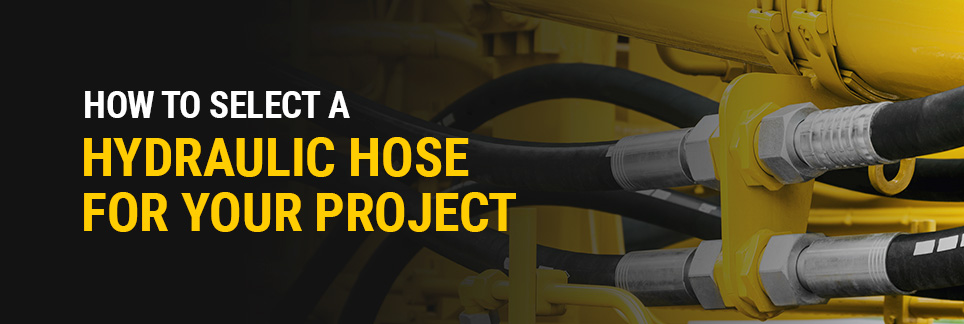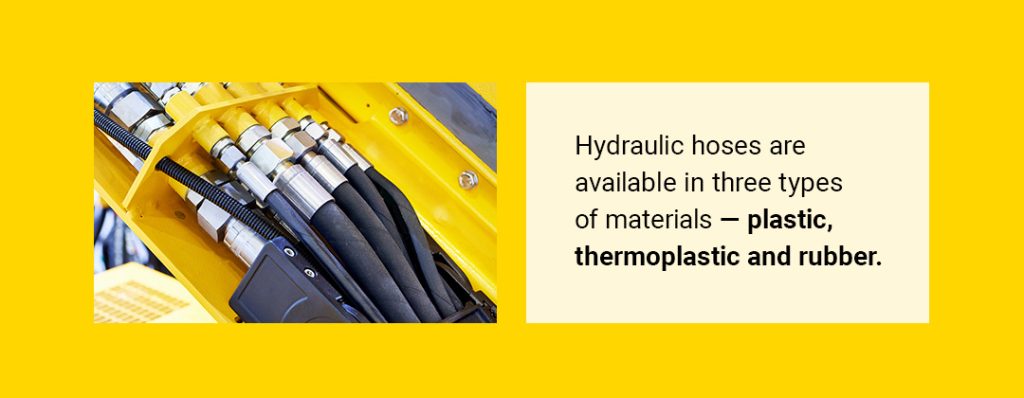
Companies that rely on hydraulic systems understand the significance of using the right hydraulic hose. Choosing the wrong hose can negatively affect the equipment’s longevity, efficiency and safety. To ensure optimum usage, you need a hose of the right material, length, diameter and rating. This guide provides an overview of the important factors to consider when selecting a hydraulic hose for your project.
Hydraulic hoses may appear interchangeable, but each type is designed for a specific application. You should consider several important factors when choosing a hydraulic hose for your project.
One of the most critical factors to consider is the size of the hose. In this context, size refers to the length and diameter, which affect the flow rate of the medium transported.
The right size hose ensures the fluid velocity stays at optimum levels. Too small a hose can increase heat and pressure, while too large a hose can reduce the equipment’s efficiency. The length of the hose should also be adequate to allow for flexibility and movement within the system. It should not be too long, either, as this may cause snags or abrasion.
Choose the length and internal diameter based on the hydraulic system you plan to use. Measurements known as dash sizes or dash numbers are used to identify the fitting size of the hose.
Temperature considerations involve two main areas of focus:
The material of the hose must be able to withstand the temperatures in both scenarios. While low temperatures may cause brittleness, high temperatures can quicken rubber aging. Ensure the hose’s temperature rating is equivalent to or higher than the ambient and media temperatures.
If the fluid temperature is high or if you operate in a high-temperature environment, a hose with high-temperature resistance is required. In addition to the material, different constructions are designed for different temperature requirements.
Hydraulic hoses have wide applications, ranging from mining to construction. They are used in industrial machinery, petroleum machinery, oil tank trucks and watering cart tank cars. Before even thinking about which hydraulic hose to choose, you must first know where and how it will be used. Specific applications would require the use of specific hydraulic hoses. For example, if the hose is going to come into contact with rough or abrasive surfaces, you’ll need abrasion-resistant hoses.
Your choice may also depend on specific industry requirements or regulations. Government agencies, such as the American Bureau of Shipping and the United States Coast Guard, determine the standards for specific industries. Select a hydraulic hose that meets your application’s legal and functional requirements. To understand how to select a hydraulic hose that meets these requirements, you must read and understand the regulations set by these government agencies.

The hydraulic hose must be compatible with the fluid or medium flowing through it. Compatibility covers not only the inner tube but also the hose fittings, the cover and the o-rings. Hydraulic fluids like synthetic oil, water-glycol mixture or mineral oil can have different chemical properties.
Hydraulic hoses are available in three types of materials — plastic, thermoplastic and rubber. Each of these materials has its own operational characteristics. The medium and hose material must be compatible to avoid chemical reactions that can lead to leaks, deterioration or system failure.
Your hydraulic hose should be able to operate within the system’s maximum working pressure. There should also be a safety margin to cover surge pressures or spikes. Choosing a hose with the correct pressure requirements will prevent hose bursts and leaks.
Choose the correct end fittings for the hose. The correct end fittings are essential in creating a leak-free connection. In addition, the right fittings will be compatible with the existing system components, making it easy to install and maintain the fittings and components. Select the hose ends based on the specific requirements of the equipment.
You should also consider the equipment’s delivery requirements, such as flow rate and distance. The correct hydraulic hose will ensure the system can deliver the required flow rate with minimal drops in pressure. Delivery ensures optimal fluid volume and velocity in the hose for system efficiency.
You should choose a hose type depending on the project you’re undertaking so it matches the specifications of your system and its environment. To ensure the hose matches these requirements, look at these nine essential specifications:
Industry-standard specifications such as the International Standards Organization (ISO) and the Society of Automotive Engineers (SAE) also significantly influence the choice of hydraulic hoses, providing a benchmark for performance and quality.
The consequences of using the wrong hydraulic hoses may include the following:
Choosing the right hydraulic hose will ensure you avoid financial losses associated with downtime and equipment damage. In addition, it’s important that you comply with industry standards on the use of hydraulic hoses in specific applications. We can help you get the right hydraulic hoses and other parts for your project. Gregory Poole is a valued partner to the heavy industry in North Carolina. Please get in touch with us for more information.
